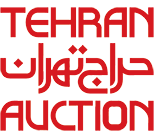The present realist portrait of Mirza Ali Khan Amin-o-Doleh, a statesman of Naseri and Mozafari eras, was painted in oil by Abdul Motaleb, otherwise known as Mirza Motaleb Khan the Advisor. Mirza Ali Khan Amin-o-Doleh, whose portrait we see here, was the son of Mirza Mohammad Khan Sinaki, an adept diplomat and author of the Naseri period. He was appointed the Secretary of the Ministry of Foreign Affairs at age fifteen. Soon he became the Secretary of Naser-e-Din Shah, and after his uncle, Pasha Khan Amin-ol-Molk, died he was titled Amin-ol-Molk. He was appointed the Minister of Tasks and Endowments to receive his father’s title – Amin-o-Doleh. Appointed Mozafar-e-Din Shah’s Prime Minister as well as Administrator of State Postal and Mint Office, Mirza Ali Khan Amin-o-Doleh was considered one of the most prominent reform-minded, avant-garde figures of the Qajar period.
The portrait accurately illustrates the western approaches in painting, including the effect of photography on painting as well as popularity of oil painting and easel painting. Further, emergence of modern trends in art coupled with an alienation of artists with Persian painting exerted a great influence on his tendency toward Realism. Early paintings of the period lacked diversity of color verging, to a great extent, on reproduction. On the whole, artist’s palette – except in some instances – did not enjoy richness of color of the past or even future. Indeed, enjoyment derived from reproduction, a fresh achievement in Iranian art, turned Realism and Naturalism into Iran’s mainstream art for a long time. Utopian aspects, similar to what once prevailed in Persian painting, temporarily turned pale when encountered this realist perspective on representation of the surrounding world.
Although a kind of commercial iconography became popular during the Safavid period, early realist portraits, including the present one, generally served the noble, rulers, statesmen and court people in the Qajar period as an independent object. In addition to portraits that appeared in the work of naturalist painters, such as Sani-ol-Molk, Kamal-ol-Molk, Abu Torab Qafari and Mirza Musa, similar portraits were reproduced in newspapers and some illustrated books of the period that used lithography as a printing technique.
In the genealogical study of this cultural movement, it should be noted that in the middle of the Qajar period, a group of Iranian students and artists were dispatched to Europe for the first time to acquire knowledge and study western culture. Among the students, Abdul Motaleb and Mozayen-o-Doleh both were architects and promoters of Western – Naturalist – academic painting in Iran. Subsequently, artists such as Sani-ol-Molk (Kamal-ol-Molk’s uncle), Abu Torab Qafari (Kamal-ol-Molk’s elder brother), and Kamal-ol-Molk himself, also adopted Iranian Naturalist painting as the leading figures of the movement. The movement later emerged as Iranian academic painting.
Abdul Motaleb was born in Isfahan and traveled to Tehran to study arts. He started his artistic career by making penholders, then switched to watercolor painting, and finally continued with oil painting due to his interest. He is said to have been skilled in producing watercolor paintings and even when Mozafar-e-Din Shah took the throne, he produced a watercolor painting of him which, as admired by the Shah, was hung on the wall of the Hall of Mirror. An oil painting garden signed “a servant of the court of Mirza Motaleb” is another well-known work of Mirza Motaleb Khan the Advisor, which according to art historian, Karimzadeh Tabrizi, is held at Reza Abbasi Museum.

